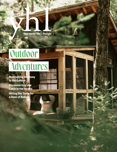Where the Wild Things Are
Keeping Garden Flora and Fauna in Harmony
Garden growth draws additional visitors—of the welcome and unwelcome varieties. Not every home gardener will encounter the same species, but you’ll find evidence of wildlife in most home gardens throughout North America. Aphids, beetles, slugs, and earthworms are common crawlers in residential areas; birds like robins, starlings, and blue jays are frequent fliers; while critters like raccoons, squirrels, and gophers can be found in urban and rural areas alike. All of these species serve a purpose in your local ecosystem and add varying levels of value. Here, we share some tips for living peacefully with the critters who make your garden their home too.
Utilize resources like your nearest extension office (it may be tied to a university or cooperative) for helpful information on local flora and fauna. Your favorite nursery may also have suggestions for both attracting and deterring certain visitors. Better understanding the connection between local plant life and wildlife will help cultivate that green thumb and keep your garden thriving.
One of the best ways to keep insects and mites from decimating your garden is by planting strategically. Sometimes referred to as companion planting, it’s the same logic behind the rosebushes you see among the grapes at vineyards. When planted at the end of a row, rosebushes attract pests like aphids and alert vintners to their presence. In a similar way, you can use plants like sunflowers, bee balm, and dill to keep pesky insects away from your produce, petals, and house.
Popular blooms like marigolds, petunias, and chrysanthemums are some of the hardest workers in your garden. Not only do they attract helpful pollinators, but they deter pests like aphids, cabbage worms, and slugs. Herbs like thyme, rosemary, and lavender are additional garden stalwarts. Plant them around raised beds or your compost pile to keep unwanted insects and critters like rats and gophers away. Mint has similar pest-control properties—just make sure to use a pot or container to keep it from spreading.
Compost piles are a backyard staple notorious for attracting wildlife, from bears and opossums to rats and mice. To reap compost benefits without nighttime visitors, avoid tossing meat, fat, or dairy scraps into the bin, and use a style with a solid bottom and secure lid. Keep in mind that this style will make it harder for those helpful earthworms to enter and aid decomposition, so you may have to introduce them to the compost yourself.
Of course, no matter the measures you take, local animals and insects will always make an appearance in your garden. With a little planning and maintenance, you can maximize the benefits and mitigate the damage of your wildlife neighbors.
For the Pollinators
It’s no secret that pollinators are both vital to your garden and dwindling in alarming numbers. Keep them happy with a mix of ground cover and fragrant blooms. Sweet alyssum, salvia, dahlias, and fuchsias are popular choices for their pretty appearance and abundance of pollen and nectar.
You can further entice pollinators to your yard by focusing on biodiversity. Cultivating plant life that’s native to your ecoregion will dramatically increase the number of bees, butterflies, hummingbirds, and other delightful visitors. One of the best ways to restore your home’s native landscape is by swapping your maintained yard for native grasses and shrubs. Map out a plan with resources like the Audubon Native Plants Database or the US National Parks Service’s Pollinator Planting Guide Cards.
/ Written by Victoria Hittner
Photography provided by Lily Reid/iStock/Getty Images





